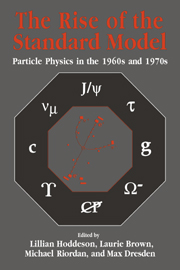Book contents
- Frontmatter
- Contents
- Contributors
- Editors' Acknowledgments
- Photographs of the Symposium
- Abbreviations and Acronyms
- Mathematical Notation
- Part One Introduction
- Part Two Quarks and Leptons
- Part Three Toward Gauge Theories
- Part Four Accelerators, Detectors, and Laboratories
- Part Five Electroweak Unification
- Part Six The Discovery of Quarks and Gluons
- Part Seven Personal Overviews
- 35 Quarks, Color, and QCD
- 36 The Philosopher Problem
- 37 Should We Believe in Quarks and QCD?
- 38 A Historical Perspective on the Rise of the Standard Model
- Index
38 - A Historical Perspective on the Rise of the Standard Model
Published online by Cambridge University Press: 03 February 2010
- Frontmatter
- Contents
- Contributors
- Editors' Acknowledgments
- Photographs of the Symposium
- Abbreviations and Acronyms
- Mathematical Notation
- Part One Introduction
- Part Two Quarks and Leptons
- Part Three Toward Gauge Theories
- Part Four Accelerators, Detectors, and Laboratories
- Part Five Electroweak Unification
- Part Six The Discovery of Quarks and Gluons
- Part Seven Personal Overviews
- 35 Quarks, Color, and QCD
- 36 The Philosopher Problem
- 37 Should We Believe in Quarks and QCD?
- 38 A Historical Perspective on the Rise of the Standard Model
- Index
Summary
The establishment of the Standard Model marked the attainment of another stage in the attempt to give a unified description of the forces of nature. The program was initiated at the beginning of the nineteenth century by Oersted and Faraday, the “natural philosophers,” who, influenced by Naturphilosophie, gave credibility to the quest and provided the first experimental indication that the program had validity. Thereafter, Maxwell constructed a model for a unified theory of electricity and magnetism, providing a mathematical formulation that was able to explain much of the observed phenomena and to make predictions of new ones. With Einstein the vision became all-encompassing. In addition, Einstein advocated a radical form of theory reductionism. For him the supreme test of the physicist was “to arrive at those universal elementary laws from which the cosmos can be built up by pure deduction.” A commitment to reductionism and a desire for unification animated the quest for the understanding of the subnuclear domain – and success in obtaining an effective representation was achieved by those committed to that vision.
The formulation of the Standard Model is one of the great achievements of the human intellect – one that rivals the genesis of quantum mechanics. It will be remembered – together with general relativity, quantum mechanics, and the unravelling of the genetic code – as one of the outstanding intellectual advances of the twentieth century. But much more so than general relativity and quantum mechanics, it is the product of a communal effort.
- Type
- Chapter
- Information
- The Rise of the Standard ModelA History of Particle Physics from 1964 to 1979, pp. 645 - 684Publisher: Cambridge University PressPrint publication year: 1997
- 3
- Cited by



